
Project describes how to build a house fire information system with the concept of fire location information detail of the room.
The development of a home fire information system with the implementation of Internet of Things-based communication (IoTs) was built using several smoke sensor components and a fire detection sensor integrated with an Arduino Uno microcontroller and Ethernet as a fire detector client. While on the server-side using Apache Web Server, PHP and mySQL database.
The stages of home fire information system analysis using the application of the internet of things (IoTs) can be explained by using descriptions in Figure 1.
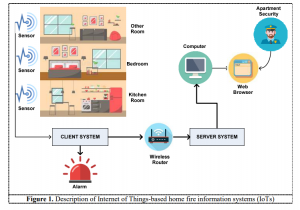
In the picture, it is explained that every room in one house has sensors that will detect smoke and fire. From several sensors, in the event of a fire, the sensor will send data to the client system, and automatically the local alarm contained in the house goes off and the client system sends fire data to the system server via the wireless router. From the system server, the officer will see the location information of the house and room details where the fire occurred while giving an alarm through the web browser.
For the stage of the fire detector system design and the house fire information system is built using a block diagram as shown in Figure 2 .
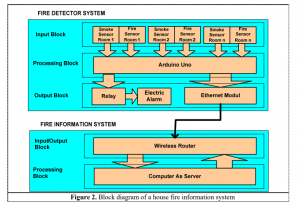
As seen in the fire detector system there is an input block with smoke sensor components and subsequent fire sensors on the processing block using Arduino Uno. Data processed from Arduino is sent to the module’s Ethernet output block as the data sender. The Arduino has another output which is a local alarm in the form of an electric alarm. Data is sent via a computer network through the wireless router to the home fire information system. Data received by the information system is redistributed to other computers in the same computer system network as the fire or distribution information system through internet hosting.
On the server-side PC-based computers that are used as servers, there are several components to run a home fire information system. In the process of accessing and storing fire data, the fire detector or client system accesses the PHP engine and saves data to the MySQL database, and issues sensor data from the mySQL database. While the officers access the fire information from the web server as shown in Figure 3.

Based on the design of a house fire detection system that is adjusted to the design in Figure 2 and the house fire information system architecture as shown in Figure 3, this study has produced a fire detection system based on the space in each house as seen in Figure 4.
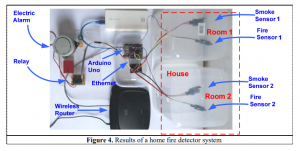
The fire detector system was developed that the fire detector system was built using two constructs such as a room and, in this test, used two plastic containers to replace the room in one house. Each room is given a smoke sensor and a fire detection sensor that is connected to an analog port on the Arduino Uno microcontroller. And from the microcontroller as the output is connected to a relay that is connected to an electric alarm. While the other output is an Ethernet module (WizNet W5100 can be used here )that is connected to the Arduino Uno microcontroller. Ethernet connection through WizNet W5100 to the Wireless Router serves as a means of connecting data transmission to the information system server.
The house fire information system that has been built can be seen in Figure 5.
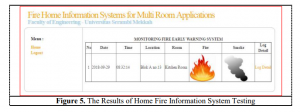
The information system shows a website built using a PC computer that is made as an information system server. To run a fire information system website, the Apache server web application is integrated with PHP engine and MySQL database.
In the process of testing a fire detector system in one room is given smoke and fire. From the test, it can be seen that the fire detector system detected smoke and fire as seen in the Arduino IDE Monitor. Figure 6.
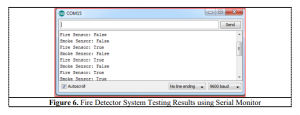
While the smoke and fire data that has been sent to the information system will produce information on the date, time, location of the house, room, fire, and smoke. Information and smoke represent pictures of smoke and fire icons with fire icon images as shown in Figure 5.
Hence this prototype testing is expected to provide benefits to the field of fire disaster mitigation and in anticipating more fire victims.

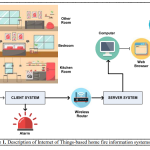
COMMENTS